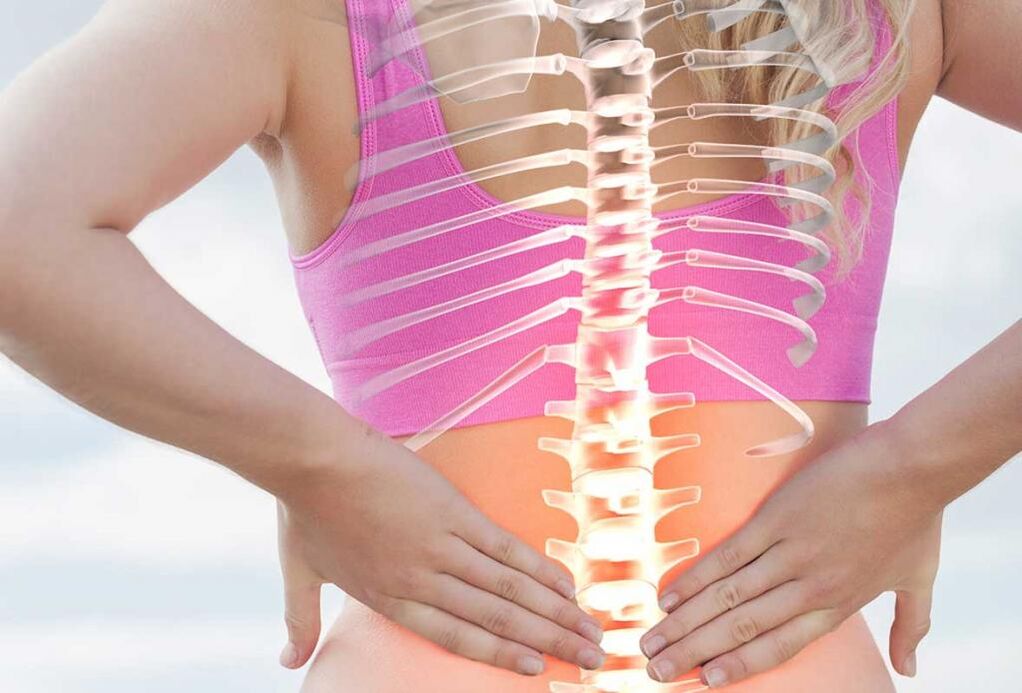The lumbar spine connects the thoracic region with the sacrum and has 5 vertebrae for great flexibility. Regardless of one's lifestyle, this part of the ridge carries a considerable load on a daily basis. For this reason, lumbar osteochondrosis is considered a very common pathology in which the intervertebral disc between the vertebrae is deformed. Dangerous complications can occur without proper treatment.

Common symptoms of lumbar osteochondrosis
The first and main sign of the development of the disease is persistent acute pain in the lumbar region. Pain may come on suddenly. Loss of flexibility in the back makes it difficult for a person to turn or lean. In some cases, the pain spreads to the lower limbs or buttocks.
The following major signs distinguish the disease:
- Increased pain with mild physical activity, coughing or sneezing;
- Impaired mobility in the lumbar region after prolonged holding in one position;
- Persistent tension in the back muscles;
- back pain;
- tingling and tingling sensation, chills in the lower extremities;
- Sensory disturbances in the thighs, buttocks, and sometimes even the feet;
- disturbed sweating;
- Spasms in the arteries of the feet, and the pulse may disappear;
- In painful areas, peeling and dry skin may lose sensitivity.
Many times, patients with lumbar osteochondrosis experience irritability and generalized fatigue. It is difficult for a person to find a comfortable position to relax in bed, and as a result, the patient's sleep is disturbed. In addition, this pathology may violate the function of the organs of the genitourinary system.
Drug therapy for lumbar osteochondrosis
Prescribes the treatment of diseases with the help of drugs:
- relieve pain;
- relax tense muscles;
- Reduce inflammation of nerve endings;
- To improve metabolism in tissues;
- restore damaged cartilage tissue;
- Normalize blood flow.
All of the above tasks are addressed by a doctor's properly selected individual treatment regimen.
To treat this disease, the following medicines are prescribed in the form of tablets:
- To relieve pain, an analgesic with a rapid action - Analgin is used. It should be remembered that in the acute course of osteochondrosis, these drugs are characterized by short-term effects;
- To reduce pain and reduce inflammation, use non-steroidal anti-inflammatory drugs;
- Chondroprotective agents are used to protect cartilage tissue from further damage;
- In addition, in order to improve the patient's condition, it is recommended to take vitamin tablets, immunomodulators.
Medications include the use of creams, ointments, and gels. All topically applied drugs can be divided into the following groups:
- Medicines that contain analgesics or anti-inflammatory nonsteroidal drugs. This group has analgesic effect;
- Combination medication. These drugs aid in tissue repair and are anti-inflammatory and absorbable. They are characterized by analgesic and thrombolytic effects;
- Drugs with analgesic and local stimulatory effects. They dilate blood vessels, increase blood flow to the affected area, and normalize metabolic processes;
- chondroprotective agents in the form of topical preparations;
- Homeopathy is characterized by anti-inflammatory and anti-edema effects. They have analgesic and restorative properties.
In addition, massage creams with anti-inflammatory and anti-inflammatory properties have also shown good results. These drugs are characterized by an analgesic effect.
We should not forget to inject this drug treatment for lumbar osteochondrosis. Injections help get the drug into the body in a short period of time. Spinal blocks are thought to be effective - an anesthetic is introduced where the nerve root is affected. Using this method, you can get quick pain relief.
Blockers are used for emergency pain relief, reduce muscle spasms, tension and tightness, and have a positive effect on the inflammatory process.
In addition to blocking osteochondrosis of the lumbar spine, a common injection for intramuscular or intravenous administration is prescribed.
To relieve psychoneuropathology, sedatives, anticonvulsants, and antidepressants can be used.
With the manifestations of radiculopathy, doctors prescribe diuretics, and with paralysis - take anticholinesterase drugs.
The pharmaceutical industry produces vast quantities of medicines to fight disease, which can only be prescribed by doctors.
Physical therapy for lumbar osteochondrosis
To be effective in the treatment of lumbar osteochondrosis, drug therapy should be supplemented with physical therapy:
- Electrotherapy is considered one of the most common ways to relieve inflamed muscle soreness. The process uses low power current. The course of treatment - 6 procedures;
- Laser therapy can eliminate inflammation and improve microcirculation. The affected area is affected by electromagnetic waves and quantum particles. The infrared beam penetrates deep into the tissue, stimulates the metabolic process, and activates the repair of cartilage tissue;
- Regulator therapy. The essence of the method is the extension of the spine under its own weight. A special mattress was used. This method allows you to normalize muscle tone;
- Shockwave therapy can relieve pain and reduce swelling. The essence of the method is the effect of constant or variable magnetic fields of different frequencies;
- Ultrasound therapy can help relieve inflammation and pain. The ultrasound acts on the affected area point by point, activating metabolic processes.
In addition, UV irradiation and vibration therapy can be performed on the vibrating massager.
Lumbar osteochondrosis is considered a fairly common disorder. If left untreated, the pathology can lead to dangerous complications. Comprehensive treatment of osteochondrosis usually eliminates the unpleasant manifestations of the disease and allows the patient to return to daily life.



















